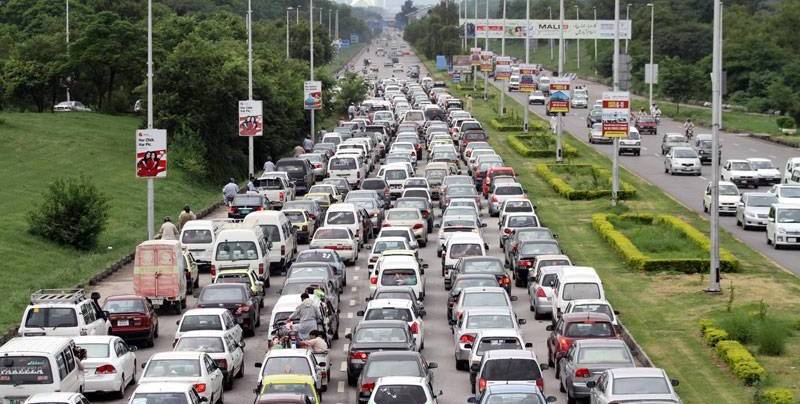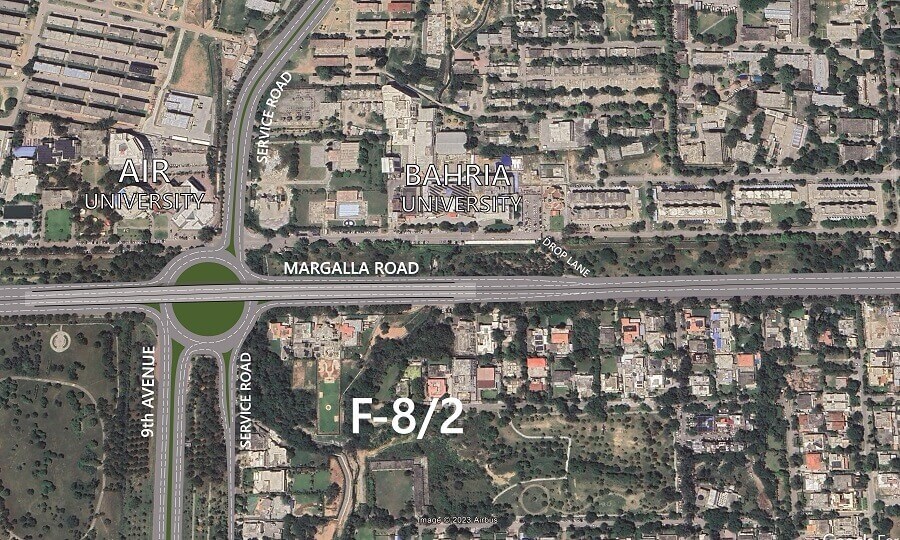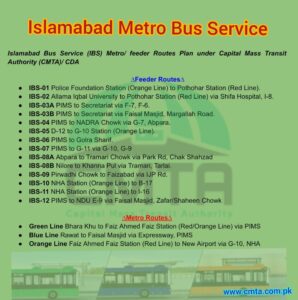
Prime Minister Shehbaz Sharif recently unveiled a plaque at the project's groundbreaking to build a flyover at Shaheen Chowk in Islamabad. A map shown in the tweet from his office shows that the flyover will span the main Margalla Road, alternatively known as 'Khayaban-e-Iqbal'. Beneath it, a massive roundabout will connect Margalla Road, Service Roads E-8/ E-9, 9th Avenue, and Service Road F-8.
https://twitter.com/PakPMO/status/1679134416050765829
https://twitter.com/PakPMO/status/1679132661804064777
This flyover is the newest addition to the new highway and interchange projects initiated in Islamabad, such as 11th Avenue, Park Road Expansion, Lehthrar Road Expansion, and other such projects.
While the projects may provide an accelerated corridor for the well-to-do to traverse the narrow band that is Islamabad, what no one has stopped to consider is that these projects have negative implications for the environment, considering emissions from automobiles are a huge source of pollution.
The project is likely to result in an exponential increase in traffic on the Main Margalla Road, thanks to the simple concept of "Induced Demand": The more space you give to cars, the more cars will come to use it.
The project's proximity to the Margalla Hills will likely impact the ecosystem of the hills due to the increased pollution and a rise in temperature.
Given that it will take at least a year to complete the project, considering periods of similar projects constructed elsewhere in Islamabad, the construction process will likely cause additional pollution in the form of the noise and dirt it kicks up.
Apart from the flora and fauna in the Margalla Hills, the project will also greatly disturb residents and students at the Bahria and Air Universities that operate around Shaheen Chowk. The constant noise, air pollution, and traffic congestion expected to be caused by roadblocks and diversions are sure to carry an impact.
Once it is completed, the increase in traffic and congestion will also add to parking issues for students at the nearby Bahria University. Many students are already told to park outside the university on Main Margalla Road. Once the project is complete, students will likely have to find a parking spot in Sector F-8/2's Medina Market and then attempt to cross eight fast-traffic lanes to get to their university. The biggest concern is the potential hazard this creates for students and motorists on this road.
These days, when students of Bahria and Air universities have to cross the Main Margalla Road, they're allowed to do so safely thanks to the momentary pause in traffic at Shaheen Chowk's signals. Once these signals are removed, and a flyover has cars racing down Main Margalla Road, crossing the road will be nothing short of deadly.
According to the 3-D renders, the road will likely have a minimum of six to eight lanes culminating near the 'drop lane' of Bahria University, and that is a lot of distance for a student to cover multiple times a day safely. Students of Bahria University have to cross the Main Margalla Road several times a day. Many students find it hard to cross the road on foot in the face of such heavy traffic, fearful it may cause deadly and tragic accidents.
Besides the environmental considerations, one reason urban planners are keen to build car-free streets next to educational institutions worldwide is that exhausted students cannot be trusted to cross a six or an eight-lane road.
Pedestrian Bridges can be constructed for crossing, but as we have seen in the case of other projects, such as the IJ Principal (IJP) Road project, and the Kashmir Highway, they are not a top priority for the city's planners and developers. Building a pedestrian bridge or overpass for pedestrians will probably take another year or two. Until then, thousands of students of Bahria and Air universities will be at the mercy of fast and heavy traffic.

The fact is that a flyover on the Main Margalla Road is not even needed. The only reason to build this flyover is to facilitate heavy traffic from the Grand Trunk (GT) Road through Margalla Avenue to quickly reach Faisal Avenue.
The project is counterproductive because this road was never meant to be a highway since it passes by people's homes. The Capital Development Authority (CDA) is already building 11th Avenue to help carry traffic on Margalla Avenue towards Kashmir Highway.
The CDA is intricately aware of how car-centric infrastructure exacerbates climate change. Despite that, it continues to build car-centric infrastructure in Islamabad and uses the city's masterplan as an excuse. The masterplan was designed nearly 63 years ago, in 1960, predating modern concepts of climate change or current population stress.
What the CDA should have realized by now is that the increase in traffic is not solved by flyovers or interchanges; traffic is solved by public transport. For this purpose, the CDA has already announced to launch 13 new routes of the Metrobus mixed with regular traffic.
One of those routes, IBS-12, starts from the Pakistan Institute of Medical Sciences (PIMS) and ends up at the National Defence University (NDU) via Shaheen Chowk. Work on the project was scheduled to commence by June, but it is nowhere in sight. Before building massive flyovers and interchanges to 'solve' traffic, the CDA should launch additional Metrobus routes, since they are much more effective in reducing traffic.

Both universities and their students are stakeholders, and this flyover affects them directly in a very negative way. The students and the administrations of both universities should take a stand against this project. The consequences of building car-centric infrastructure are far too obvious and great to ignore at a time when Pakistan is ranked among the ten most vulnerable countries to climate change. Our government should now focus on public transport as the solution to many of our problems.
https://twitter.com/PakPMO/status/1679134416050765829
https://twitter.com/PakPMO/status/1679132661804064777
This flyover is the newest addition to the new highway and interchange projects initiated in Islamabad, such as 11th Avenue, Park Road Expansion, Lehthrar Road Expansion, and other such projects.
While the projects may provide an accelerated corridor for the well-to-do to traverse the narrow band that is Islamabad, what no one has stopped to consider is that these projects have negative implications for the environment, considering emissions from automobiles are a huge source of pollution.
The project is likely to result in an exponential increase in traffic on the Main Margalla Road, thanks to the simple concept of "Induced Demand": The more space you give to cars, the more cars will come to use it.
The project's proximity to the Margalla Hills will likely impact the ecosystem of the hills due to the increased pollution and a rise in temperature.
Given that it will take at least a year to complete the project, considering periods of similar projects constructed elsewhere in Islamabad, the construction process will likely cause additional pollution in the form of the noise and dirt it kicks up.
Induced Demand: The more space you give to cars, the more cars will come to use it
Apart from the flora and fauna in the Margalla Hills, the project will also greatly disturb residents and students at the Bahria and Air Universities that operate around Shaheen Chowk. The constant noise, air pollution, and traffic congestion expected to be caused by roadblocks and diversions are sure to carry an impact.
Once it is completed, the increase in traffic and congestion will also add to parking issues for students at the nearby Bahria University. Many students are already told to park outside the university on Main Margalla Road. Once the project is complete, students will likely have to find a parking spot in Sector F-8/2's Medina Market and then attempt to cross eight fast-traffic lanes to get to their university. The biggest concern is the potential hazard this creates for students and motorists on this road.
These days, when students of Bahria and Air universities have to cross the Main Margalla Road, they're allowed to do so safely thanks to the momentary pause in traffic at Shaheen Chowk's signals. Once these signals are removed, and a flyover has cars racing down Main Margalla Road, crossing the road will be nothing short of deadly.
One reason urban planners are keen to build car-free streets next to educational institutions worldwide is that exhausted students cannot be trusted to cross a six or an eight-lane road
According to the 3-D renders, the road will likely have a minimum of six to eight lanes culminating near the 'drop lane' of Bahria University, and that is a lot of distance for a student to cover multiple times a day safely. Students of Bahria University have to cross the Main Margalla Road several times a day. Many students find it hard to cross the road on foot in the face of such heavy traffic, fearful it may cause deadly and tragic accidents.
Besides the environmental considerations, one reason urban planners are keen to build car-free streets next to educational institutions worldwide is that exhausted students cannot be trusted to cross a six or an eight-lane road.
Pedestrian Bridges can be constructed for crossing, but as we have seen in the case of other projects, such as the IJ Principal (IJP) Road project, and the Kashmir Highway, they are not a top priority for the city's planners and developers. Building a pedestrian bridge or overpass for pedestrians will probably take another year or two. Until then, thousands of students of Bahria and Air universities will be at the mercy of fast and heavy traffic.

The fact is that a flyover on the Main Margalla Road is not even needed. The only reason to build this flyover is to facilitate heavy traffic from the Grand Trunk (GT) Road through Margalla Avenue to quickly reach Faisal Avenue.
The project is counterproductive because this road was never meant to be a highway since it passes by people's homes. The Capital Development Authority (CDA) is already building 11th Avenue to help carry traffic on Margalla Avenue towards Kashmir Highway.
The CDA is intricately aware of how car-centric infrastructure exacerbates climate change. Despite that, it continues to build car-centric infrastructure in Islamabad and uses the city's masterplan as an excuse. The masterplan was designed nearly 63 years ago, in 1960, predating modern concepts of climate change or current population stress.
What the CDA should have realized by now is that the increase in traffic is not solved by flyovers or interchanges; traffic is solved by public transport. For this purpose, the CDA has already announced to launch 13 new routes of the Metrobus mixed with regular traffic.
One of those routes, IBS-12, starts from the Pakistan Institute of Medical Sciences (PIMS) and ends up at the National Defence University (NDU) via Shaheen Chowk. Work on the project was scheduled to commence by June, but it is nowhere in sight. Before building massive flyovers and interchanges to 'solve' traffic, the CDA should launch additional Metrobus routes, since they are much more effective in reducing traffic.

Both universities and their students are stakeholders, and this flyover affects them directly in a very negative way. The students and the administrations of both universities should take a stand against this project. The consequences of building car-centric infrastructure are far too obvious and great to ignore at a time when Pakistan is ranked among the ten most vulnerable countries to climate change. Our government should now focus on public transport as the solution to many of our problems.

